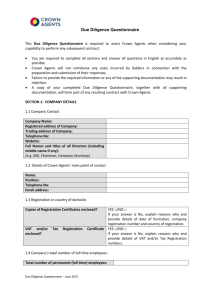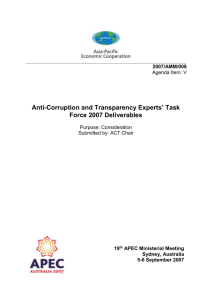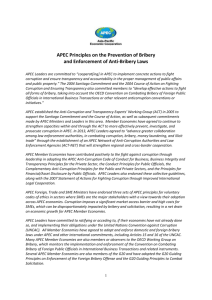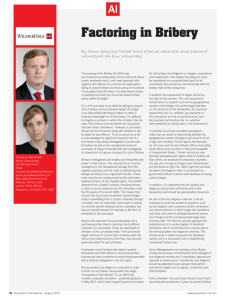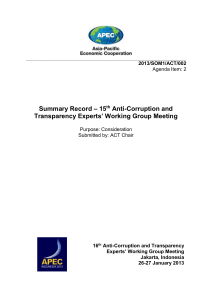APEC ACT General Elements of Corporate Compliance Program
advertisement
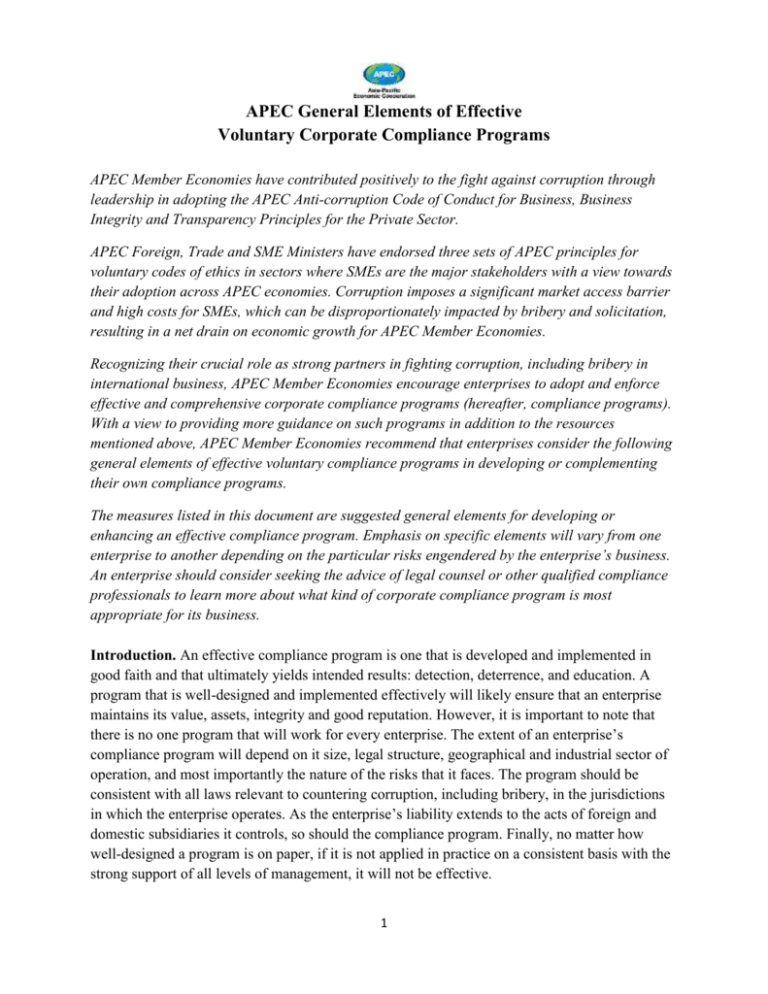
APEC General Elements of Effective Voluntary Corporate Compliance Programs APEC Member Economies have contributed positively to the fight against corruption through leadership in adopting the APEC Anti-corruption Code of Conduct for Business, Business Integrity and Transparency Principles for the Private Sector. APEC Foreign, Trade and SME Ministers have endorsed three sets of APEC principles for voluntary codes of ethics in sectors where SMEs are the major stakeholders with a view towards their adoption across APEC economies. Corruption imposes a significant market access barrier and high costs for SMEs, which can be disproportionately impacted by bribery and solicitation, resulting in a net drain on economic growth for APEC Member Economies. Recognizing their crucial role as strong partners in fighting corruption, including bribery in international business, APEC Member Economies encourage enterprises to adopt and enforce effective and comprehensive corporate compliance programs (hereafter, compliance programs). With a view to providing more guidance on such programs in addition to the resources mentioned above, APEC Member Economies recommend that enterprises consider the following general elements of effective voluntary compliance programs in developing or complementing their own compliance programs. The measures listed in this document are suggested general elements for developing or enhancing an effective compliance program. Emphasis on specific elements will vary from one enterprise to another depending on the particular risks engendered by the enterprise’s business. An enterprise should consider seeking the advice of legal counsel or other qualified compliance professionals to learn more about what kind of corporate compliance program is most appropriate for its business. Introduction. An effective compliance program is one that is developed and implemented in good faith and that ultimately yields intended results: detection, deterrence, and education. A program that is well-designed and implemented effectively will likely ensure that an enterprise maintains its value, assets, integrity and good reputation. However, it is important to note that there is no one program that will work for every enterprise. The extent of an enterprise’s compliance program will depend on it size, legal structure, geographical and industrial sector of operation, and most importantly the nature of the risks that it faces. The program should be consistent with all laws relevant to countering corruption, including bribery, in the jurisdictions in which the enterprise operates. As the enterprise’s liability extends to the acts of foreign and domestic subsidiaries it controls, so should the compliance program. Finally, no matter how well-designed a program is on paper, if it is not applied in practice on a consistent basis with the strong support of all levels of management, it will not be effective. 1 The following elements reflect the APEC Anti-corruption Code of Conduct for Business, Business Integrity and Transparency Principles for the Private Sector, referenced above, and expand upon them with a practical discussion of elements of a compliance program that supports those principles. Conduct a risk assessment. An effective compliance program for detecting and deterring corruption should be crafted upon the basis of a risk assessment taking into account the enterprise’s individual circumstances, including bribery and other corruption risks. An enterprise should conduct ongoing monitoring of its risks to assess whether changes are needed to adapt the compliance program so that it remains effective and efficient. Examples of risk factors to consider include: o the place of operation, o the industry sector, o the business opportunity, o potential business partners, o the extent of government regulation and oversight, including the exposure to customs and immigration in conducting international business, and other points of interaction with government officials. Enterprises need to allocate their resources to adequately address their highest risk areas. Ultimately, more resources should be allocated to the riskiest aspects of the business. o For example, experience has shown that when analyzing risks, it is prudent for enterprises to focus on large government bids and suspicious payments or discounts to third party agents. o However, not all third parties pose the same risks, so doing the same amount of due diligence on them all does not make sense. o Similarly, while still important to undertake due diligence, relatively routine and low level expenses on entertainment and gift giving may pose less risk and require the allocation of fewer resources. 2 Full support and participation of management. It is crucial that all of the elements of the compliance program receive the full support and participation of senior management and all layers of management throughout a company. Full management adherence and support of the program illustrates a commitment to a culture of compliance throughout the enterprise. The corporate compliance program must apply and be enforced at all levels within the company, with continual efforts to ensure awareness among all employees. Senior management must take efforts to combat corruption seriously, setting the tone at the top for employees to follow. If an enterprise’s senior management does not comply with the program, neither will its employees. Establish and adhere to a written corporate code of conduct. Corporate directors, officers, employees, and agents put themselves and the enterprise at risk of incurring criminal, civil, or administrative liability when they do not adhere to domestic and foreign anticorruption and bribery laws. A corporate code of conduct generally consists of a clearly written set of legal and ethical guidelines accessible to and understandable by all employees and those conducting business on the enterprise’s behalf. A comprehensive and clearly articulated code of conduct and a clearly articulated policy against corruption -- as well as clear policies and procedures relative to seeking guidance and making disclosures -- may reduce the likelihood of actionable misconduct by employees and third parties. Among the areas of concern that a code of conduct should address are the nature and extent of transactions with foreign governments, including payments and facilitating payments to foreign officials and related third parties; use of third party agents; gifts, travel, and entertainment expenses; and charitable and political donations. Bearing in mind that an enterprise can be held responsible for the acts of its employees, it is important that it distribute its code of conduct to everyone in the enterprise and, if appropriate, translate it into local languages where it operates abroad. An enterprise should also consider whether it should distribute its code of conduct to its business partners and agents, including intermediaries, consultants, representatives, distributors, contractors and suppliers, consortia, and joint venture partners. An enterprise may also wish to include in its code of conduct specific compliance measures and expectations for such business partners and agents. Finally, developing a code of conduct should be just an initial step in the compliance process, and not the final act. The code must be effectively and continuously implemented and enforced at all times. The enterprise should make clear that compliance is mandatory and that no employee will suffer demotion, penalty, or other adverse consequences for refusing to pay bribes even if it may result in the enterprise losing business. 3 Establish an organizational compliance structure. A compliance program may be run by one person or a team of compliance or ethics officers, depending on the size of the enterprise. Implementation of and responsibility for a corporate compliance program by senior management in the enterprise can be vital for ensuring accountability. One or more senior corporate officers (depending on the size of the company), with an adequate level of autonomy from management, resources, and authority, should oversee the compliance program. Oversight of compliance programs must include the authority to report matters directly to independent monitoring bodies, such as internal Audit Committees of Boards of Directors or supervisory boards (or their equivalent, depending on the size of the company). It is important that an enterprise devote adequate staffing and resources to the compliance program given the size, structure, and risks that the enterprise may be facing. Corporate compliance officers and committees can play key roles in drafting codes of conduct and educating and training employees, and, where appropriate, other business partners, on compliance procedures. Compliance committee members may include senior vice presidents for marketing and sales, auditing, operations, human resources, and other key offices. Past experience has shown that empowering compliance officers with access to senior members of management and with the capacity to influence overall company policy on integrity issues can be of utmost importance. Provide anticorruption training, education seminars, and continued guidance. The overall success of a compliance program depends on promoting legal and ethics training and certification at every level of the company and, where appropriate, to business partners. Regular ethics and compliance training programs should be held for all employees, including Board members, senior management officials, and agents. More specific legal and ethical training may be necessary for employees in high-risk areas. Where appropriate, an enterprise should also consider providing such training to its contractors and suppliers. Compliance programs should educate employees at all levels of the enterprise about applicable anticorruption and bribery laws, both domestic and foreign. Training and related materials need to be tailored to the recipient audience, including in the local language. Enterprises should consider focusing training programs so that they reflect the types of risks faced by the business and incorporate situations that employees may come across depending on their jobs. Training materials which are interactive, easily accessible, and cost effective can help build employee support for a compliance program. This can include web-based as well as in-person training. Training activities must be assessed periodically for effectiveness and revised to address evolving risks employees may encounter. 4 Most importantly, the discussion of and concern for compliance issues should not be limited to training classes and the compliance team: compliance should be stressed as an integral part of the enterprise's culture and way of doing business. Undertake documented, risk-based, due diligence. Conducting prompt and thorough due diligence reviews that are documented and risk-based is vital for ensuring that a compliance program is efficient and effective. Due diligence reviews are also important for preventing potential harm to the enterprise's reputation. Self-monitoring, periodic internal audits, and reports to the Board of Directors (or equivalent, depending on the size of the enterprise) are all good tools for ensuring adherence to the compliance program. A compliance program’s due diligence should also extend to third parties, such as agents and other business partners including intermediaries, consultants, representatives, distributors, contractors and suppliers, consortia, and joint venture partners, depending on their risk factors. As noted above, not all agents and business partners will pose the same risks and merit the same levels of scrutiny. From vetting new hires, agents, or business partners to assessing risks in international business dealings (e.g., mergers and acquisitions, including both pre- and post-acquisition due diligence, or joint ventures), and providing regular monitoring and oversight, due diligence reviews can uncover questionable conduct and limit liability. Enterprises should take into account the qualifications of and relationships with third parties, particularly in their business and personal relationships with government officials. o An enterprise should consider the need and the role of the third party and set forth contractually the services the third party will perform. Assessments of this nature not only reduce compliance risks, but also help to ensure that there truly is a business need to engage a third party. o Enterprises should ensure that the work the third party is doing is well documented and that the third party’s compensation is commensurate with the services provided, taking into account what is typical compensation for third parties in the industry and the place where services are rendered. o In addition, enterprises should consistently monitor their relationships with third parties, including by updating due diligence, exercising audit rights, and providing training and requiring certifications by the third party. o An enterprise should ensure that its third party business partners receive information about its compliance program, and also seek reciprocal commitments from third parties through certifications or other means. 5 Auditing and internal accounting controls. Auditing and monitoring of systems of internal accounting controls contribute toward building an effective compliance program by the early detection of inaccuracies and misconduct (e.g., bribery, fraud, or other corporate malfeasance). Enterprises should have a system of financial and accounting procedures, including a system of internal controls, designed to ensure the maintenance of fair and accurate books, records, and accounts, to make certain that they cannot be used for the purpose of bribery or hiding such bribery or other corruption. Enterprises should have a clear and concise accounting policy that prohibits off-thebooks accounts or inadequately identified transactions. Enterprises should monitor their accounts for inaccuracies and for ambiguous or deceptive bookkeeping entries that may disguise illegal bribery or other corrupt payments made by, or on behalf of, an enterprise. Compliance mechanisms and Reporting. Enforcement of an enterprise's code of conduct is critical. Compliance officers should be accessible so that employees will feel comfortable discussing any of their compliance questions or concerns. Creating secure and accessible reporting mechanisms with adequate policies on confidentiality and non-retaliation as well as other safeguards related to reporting is extremely important. Whistleblowing protections, including independent management of reporting programs and ensuring the possibility of anonymous reporting, suggestion boxes, or "Helplines" facilitate detection and reporting of questionable conduct. Enterprises should take whistleblower reporting seriously and take action, including where appropriate reporting to competent authorities, in response to reports from internal or external whistleblowers. An enterprise should also ensure that it has open channels of communication for suggestions to improve its compliance program and conduct appropriate follow up. The enterprise should consider publishing its program so that all stakeholders are aware of it. Enterprises should also ensure that they provide mechanisms for timely and appropriate guidance and feedback to employees and agents on how to cope with and resolve difficult and sometimes urgent situations. Such counseling not only protects the employee or agent, it also protects the enterprise. Incentives. An enterprise should ensure that it provides incentives for compliance to encourage and provide positive support for employees who adhere to and uphold the program against corruption, including bribery, at all levels of the company. Incentives can be provided at many levels and in varying ways: recruitment of employees who share the values of the enterprise, promotions and pay increases for employees who uphold the program, recognition for fulfilling training requirements and certifications, including in performance evaluations, and other forms of positive recognition and awards for those who are dedicated to compliance. 6 Discipline. An enterprise should ensure that all employees at every level understand that failure to comply with its compliance policy and procedures and anticorruption laws will result in disciplinary action, ranging from minor sanctions to more severe punishment, for example, where consistent with applicable law, publicizing disciplinary actions internally, to termination of employment where appropriate. An enterprise must have appropriate and clear disciplinary procedures; it must apply them fairly, consistently and promptly across the enterprise; and discipline must be proportionate with the violation. In instances of non-compliance, an enterprise should take the necessary preventive steps to ensure that the questionable conduct does not recur in the future. Periodic Review and Testing. As the enterprise’s business develops and changes, so must the compliance program. An enterprise’s compliance program must be consistently reviewed, updated and improved, to ensure that it is effective and continuously addresses the evolving risks the enterprise may encounter. Senior management of the enterprise should monitor the program and periodically review the program’s suitability, adequacy, and effectiveness and implement improvements as appropriate. An enterprise should review and test its controls and identify best practices and new risk areas. The results of the review should be periodically reported to the Audit Committee or the Board (or equivalent, depending on the size of the enterprise). The Audit Committee or the Board (or equivalent, depending on the size of the enterprise) should make an independent assessment of the continued adequacy of the program and disclose its findings in the Annual Report to shareholders. 7





